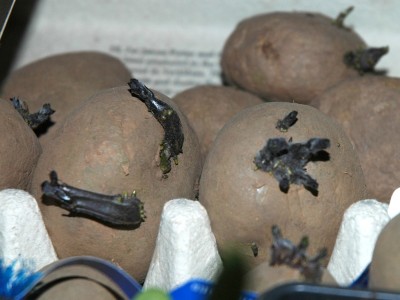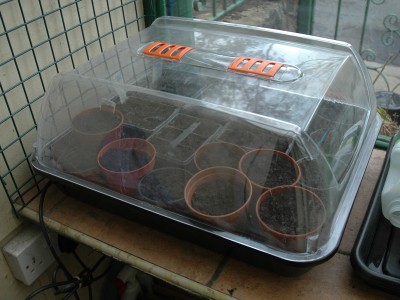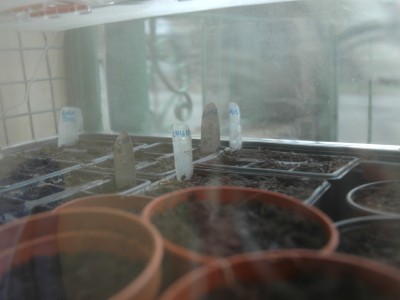Flu and what-have-you
So I got myself all stoked up to do stuff and blog about it to get myself back into the swing of things then I got the flu. The only thing that’s been productive around here in the last two weeks or so has been my phlegmy chest. I’m still not running at full steam but I thought I should try to hop back aboard the blogging train before all the carriages race away from me and this metaphor goes off the completely off the tracks ;)
These last few weeks have mostly been spent slumped on one sofa or another, watching a whole lot of films and eating a whole lot of soup. But in my slightly-better moments, I’ve done some sewing after getting a new embroidery book out of the library just before the virus hit (book review coming soon) and wandered down to see the chickens, lamenting about the sorry state of the garden and wondering if things will fruit/ripen before the frost hits.
The latter put me in a bit of a “I’m a bad gardener” slump until I realised that even with all the dead things, the things that won’t quite get there this year, the things that didn’t stand a chance and the lack of any summer sowing whatsoever, we’ve still got at least ten edible things growing in the garden that we can/will eat: achocha (outdoor – will pick soon), tomatoes (greenhouse & outdoor), courgettes, marrows (ok, so they’re essentially the same thing but we used them differently), cucumbers, peppers, chillis (all greenhouse), leeks, pumpkin and swiss chard.
And that’s before we get onto the wild greens/fruit (predominantly nettles but there are also some bullet-like blackberries at the end of the garden and the dregs of elderberries on the trees near the kitchen), the technically-edible-but-I-probably-won’t-eat-them-now things (like the new leaves/shoots on the squashes & the achocha, or the marigold leaves & heads) and herbs (rosemary, lavender & mint still going strong outside, basil & chives inside, and things gone to seed both outside & in that are still usable just not as good as before they flowered, like dill & oregano).
And it’s also not including eggs – the six girls are still kicking out on average five a day, which is nice.
When I’ve got a bit more energy/less mucus, I’ll write more about our growing year here – lots more lessons learnt and things to definitely not do next year – but this has made me feel a little better about things, that there have been some successes as well as the many failures.
What’s still on the go in your garden?
Read MoreLast of the potatoes
(Like Last of the Mohicans, except starchier.)
After expressing my meh-ness the other day, I actually had a productive few hours in the garden today. It’s John’s fault – after carrying down some chicken food for me, he stayed in the garden tidying some stuff at the bottom and I felt kinda guilted into staying out there too. I did a little weeding but then prioritised stuff that needed harvesting, namely the titular potatoes, some tomatoes & a gorgeous courgette. Some of said potatoes:
As I said a few weeks ago on Twitter, I don’t think I’ll grow potatoes next year. I’m restricted to growing them in containers at the moment and while it does have some advantages (diseases are contained and no digging!), it has plenty of disadvantages too. Most importantly, they use up a lot of soil and I don’t have access to a lot of soil at the moment, so to grow them means there is less soil/compost to go around everything else (or at least I have to buy it in – and it’s too expensive to buy in to use on potatoes). Growing them in containers also means they need more watering than they do in the ground, which isn’t terrible, just another job to do. Being in containers does, well, contain them a bit too: they don’t really get to stretch out to full capacity so the harvest isn’t as bountiful, either in number or size, as it would be in the ground. And of course, there is the diseased Satan gonad issue.
But the most important thing really is that we don’t eat a lot of potatoes – we cook with them no more than once a week, probably closer to once a fortnight. This last week we’ve not been eating wheat so our usual pasta/noodle/bread staples have been out but still, we’ve not actually eaten any potatoes (I was supposed to have jacket potato on Wednesday but had leftover risotto instead). If we were aiming to be completely self-sufficient then I suspect we’d eat more as it is easier to grow them than cereals but right now, we don’t need a whole lot of them and it seems a risk to grow a lot to use so gradually when we can buy the few we do want locally and/or organically ones for a frugal-friendly price. I’d rather use my limited soil and motivation/energy elsewhere.
Having said that, if we did have bed space for them, I’d probably be tempted to give them another go, or in a few years when I have more than enough homegrown compost to spare, I might try containers again. For future Louisa’s information, the Orla maincrop did well this year and have resulted in some good spuds, and the Charlotte-esque basic seed potatoes I got for next-to-nothing at Home Bargain also turned out well.
As for the other harvested stuff today: I collected just over a kilogram of tomatoes, mostly cherry tomatoes but a few big Romas too, for ripening inside since their home plant were looking worse for wear. Some are already orange-y but most are green; if they don’t seem to be getting with the ripening programme in a couple of days, I’ll turn them into Aurora’s chutney. There is probably about the same again out there and in dribs & drabs, we’ve (mostly John) has probably eaten about that so far. Three kilograms/six-and-a-half pounds isn’t a huge haul considering how much space they took up in my small greenhouse – some plants have been very productive but others not at all. John has *loved* the sweet cherry ones though, so I’ll definitely grow them again.
The courgette I picked was our first in our second wave of the squashes: we’ve had a few almost courgette-free weeks because I’ve been feeling meh so not picked the nutrient-hogging now-marrows from the plants, but there are lots of baby courgettes again now. The taste of summer still lingering on.
Have you been harvesting anything this weekend?
Read MoreTomatoes: determinate or indeterminate, that is the question
I think I’ve just about reached the stage where my first set of tomatoes needs potting on.
These are the ones that survived the Great Damping Off Disaster of 2011 and they seem to be doing quite well. I have some later ones that are still in modules – they’ll need moving up a stage in a week or so but I think this first batch could use moving on ASAP as I think they’re a little cramped now and starting to suffer as a result.
Up until now, I’ve been more interested in the resulting type of tomato than the actual growing process – I’m a naughty gardener, naughty naughty – and I suspect my crops have suffered as a result.
Now that I’m trying to be more efficient though, I want to do things right. This “potting on” stage now will potentially be to the plants’ final destinations so I’ve been reading about determinates/indeterminates and that sort of thing to make sure the right tomatoes end up in the right pot. According to the wonderful Wikipedia,
Determinate, or bush, types bear a full crop all at once and top off at a specific height; they are often good choices for container growing. Determinate types are preferred by commercial growers who wish to harvest a whole field at one time, or home growers interested in canning. Indeterminate cultivars develop into vines that never top off and continue producing until killed by frost. They are preferred by home growers who wish ripe fruit throughout the season.
I have planted three main types of tomatoes this year: some rich Roma plums for sauces, some sweet cherry tomatoes (Sweet Million F1 – I sowed some yellow cherry Golden Nuggets as well but they all died in the aforementioned Damping Off Tragedy), and some “standard size” Moneymakers. Nothing too exciting but some variety – some for now, some for sauces, some for whatever.
According to a bit of Googling around, I’ve found Roma tomatoes are a determinate bush, Sweet Million an indeterminate vine and Moneymaker is another indeterminate vine, albeit with slightly bigger fruit.
I had hoped to grow some in the greenhouse (in big pots and growbags) but had thought I’d take advantage of some vertical height in the garden by growing some in hanging baskets/upside down containers too. (Although I’d keep said baskets/containers in the greenhouse for at least another few weeks until it gets a bit warmer.)
eHow (which I admittedly always read with a slightly sceptical eye) tells me:
For baskets, you will want to use determinate tomato plants because they will not continue to grow bigger than the basket can hold, while indeterminate ones will.
But equally, I have to consider tomato size:
The size of the tomato plays an important role in whether or not it is going to be best for growing in baskets. Traditionally, there is less room in hanging baskets for a plant to reach full maturity. Therefore, cherry tomatoes, grape tomatoes and other dwarf tomatoes will work best in hanging baskets.
Ok… The “standard size” indeterminate Moneymakers seem destined to grow as cordons from pots/bags in the greenhouse – easy peasy. But what about the Roma & cherry tomatoes? The determinate Roma may be suitable for a hanging basket as they won’t sprawl, but perhaps the plum size fruit will be too big/thirsty for in a basket? The cherry tomatoes are the perfect size for a basket but my variety’s indeterminate nature may cause problems there…
Any experienced tomato growers care to weigh in? Do you prefer all determinate or all indeterminate or a combination of the two?
Read MorePotatoes, seedlings, big bulldogs & have-a-go bullycats
I’ve been really careful, well, kinda careful this year to not overwhelm myself with seedlings.
It’s a bit of a balancing act, isn’t it? Ensuring that you sow enough to get adequate germination and to survive the tribulations of growing into seedlings, being transplanted and being put somewhere that ninja slugs might reach them (nevermind late frost snaps, being sat on by the dog or a myriad of diseases and other pests) – BUT not sowing too many that it’ll overwhelm your available resources (including time and space).
Last year, I accidentally grew way too many squash and nearly all the rest of my veggies suffered as a result – I’m keen not to make that mistake this year so have been cautious when it comes to buying and planting. Or at least I thought I had been – even though I’d resisted the cheap large bags of seed potatoes I’d seen, the small amount of seed potatoes I have bought are going to go further than I thought.
This afternoon I’ve planted out some Swift potatoes – which apparently provide small but very early spuds – and used up a third of my existing potato containers/bags — and I’ve still got another six varieties chitting and nearly ready to plant out. Admittedly I’ve only got a small amount of each variety but still, by my maths, I’ll need at least another eight to ten containers/bags for them all. It’s times like these that I really wish I had an allotment or at least beds that were deep enough/wide enough to warrant rows.
Any recommendations for potato-growing containers/bags or stuff to reuse for said containers?
I’ve also asked on Twitter for recommendations for topsoil and/or compost suppliers – we just don’t have any spare soil in this garden and our compost heaps aren’t pumping out enough of the brown stuff just yet. If anyone else has any suggestions around Leeds/Bradford or offering affordable delivery from elsewhere, I’d love to hear them :)
Aside from the potatoes, it’s all go in my seedling nurseries – I’ve got stuff that needs a warm environment (tomatoes, peppers, chillis, squash, cucumber) in the propagator, and stuff that doesn’t mind the cold (early lettuce, broad beans and after being reminded about them by Gillian, radishes) in the greenhouse. Lots and lots of green shoots popping up. But hopefully not too many of any one thing ;)
The jostaberry canes are planted out too – although that little job was interrupted by a big bulldog coming over to meet Lily-dog and Boron the old, toothless cat deciding he wanted to fight said big bulldog to prove his manliness or something. Thankfully the bulldog is good around cats so just tried to get out of the way of Boron’s swats but a scary few minutes for me all the same!
Read MoreCheck out my proper whopper of a propa(gator)! ;)
Yesterday I got a bit over-excited on Twitter because my heated propagator arrived.
I’d been thinking about getting on for a while but Fiona, the Cottage Smallholder, gave me the final push at the weekend. I got one on eBay on Saturday for £19.99 + £3.95p&p – and was quite surprised how quickly it arrived.
I was also rather surprised at the size – I had chosen one that looked a bit bigger than standard because it didn’t cost that much more and I had a feeling I’d appreciate the extra space – but it turns out that 52cm by 42cm is really pretty big! Thankfully it fits quite neatly onto the shelf in our porch – and conveniently right next to an electric socket too. One of the reasons I was resisting was a worry about the running cost. The heating element in this one is 18W, which, if my calculations are correct, will cost us 3.4p a day to run – I imagine I’ll run it for a week or so at a time, for a few months so not too much overall.
This morning I filled it with its first batch of seeds to nurse – plugs of tomatoes, chillis & cucumbers. (I told myself that I wouldn’t use plugs this year because it means more work but apparently I’m not very good at sticking to my word. The pots are more tomatoes that I sowed the other day, before I’d done a u-turn on my no-plugs rule.) I’m looking forward to seeing them get started.
It was nice to be preparing the plugs in the greenhouse – the sun had been on it for a couple of hours so it was pleasantly warm. Carla-cat followed me inside and stretched out on the warm aluminium staging for the duration. While I was in there, I also started some broad beans in pots – the end of my bought packet & some saved seeds from last year. Possibly a little early but we’ll see.
Read More










